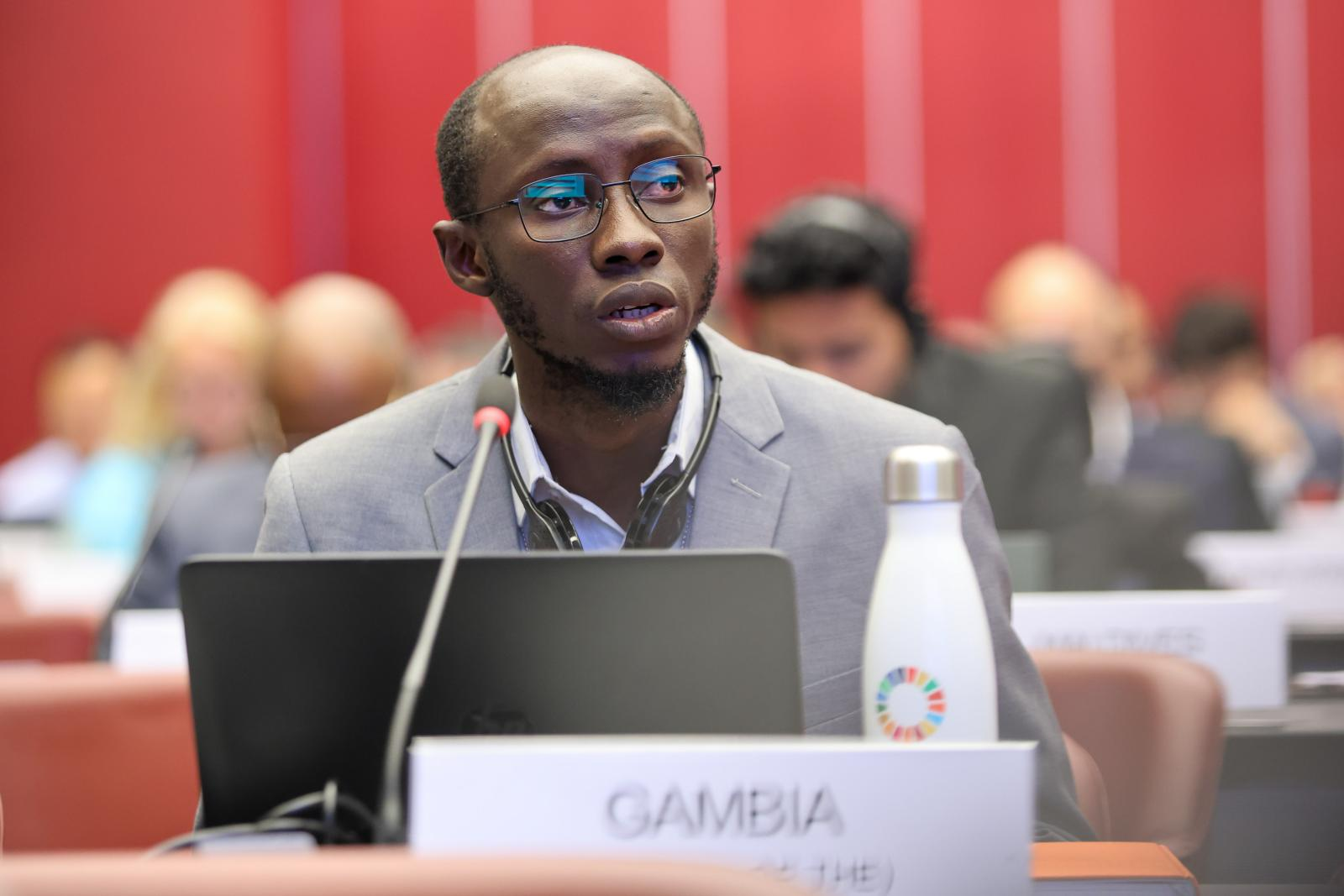The blog is written following an interview with Ms. Eustacia Jennings, Principal Consultant and CEO of JESS Consultants, as part of a Series of NIP Dialogues under the Global NIP Update project (GEF ID 10785), funded by GEF and led by UNEP.
NIP Dialogue Series – Voices from the Countries
What does it take to update a National Implementation Plan (NIP) for Persistent Organic Pollutants (POPs) in a Small Island Developing State (SIDS)? In this second installment of the NIP Dialogue Series, we follow the journey of Eustacia Jennings, lead consultant for The Bahamas NIP update. Her experience offers a candid look at the systemic, institutional, and human challenges behind NIP development, with valuable lessons for chemicals management professionals across the globe.
Data collection challenges and legislative constraints
One of the earliest and most persistent challenges Jennings faced was data collection. In The Bahamas, data on POPs stocks and flows were fragmented, inconsistent, or simply unavailable. Without a legal mandate or binding requirement to report PCBs in oils, PFAS in foams, or other POPs, some organisations, especially in the private sector, lacked such data to begin with. Even government ministries had no obligation to coordinate or share data.
According to Jennings, this dynamic created a climate of uncertainty. With no assurance of data completeness or consistency, the team had to repeatedly verify and supplement information. In hindsight, she emphasized that establishing a legal framework for mandatory reporting would fundamentally shift the dynamics, from depending on voluntary cooperation to building a culture of compliance and accountability. Jennings and her team recommended introducing such legal requirements as part of future regulatory improvements, particularly for emerging POPs.
Stakeholder engagement: From awareness gaps to fatigue
Alongside data hurdles came the challenge of stakeholder engagement. Awareness of POPs and the Stockholm Convention varied widely. While a core group of government stakeholders, particularly those in the National Working Group (NWG), was already familiar with the obligations and were to some extent exposed to previous NIP work, many others in sector-specific agencies and private industry lacked even basic terminology. Low levels of awareness often reinforced disengagement.
To bridge this knowledge gap, the executing agency, BCRC- Caribbean, created a project briefing note explaining the purpose of the NIP update, background of the project, timeline and expected contributions of each stakeholder. This document became essential for onboarding new participants, new stakeholders and aligning expectations. Yet, participation remained uneven.
A deeper issue emerged alongside continuous engagement for NIP update: stakeholder fatigue. Many individuals are involved in multiple environmental initiatives, including climate change reporting, the Minamata Convention and others. With overlapping demands and data requests, the same actors were often approached repeatedly, leading to disengagement. In contrast, Jennings noted that newcomers or recently appointed officials were often more enthusiastic and open to collaboration.
To manage this dynamics, the team used tailored outreach, including direct calls, site visits, in-person meetings, workshops and one-on-one interviews, especially when email surveys yielded low response rates. Sector-specific outreach, such as a visit to The Bahamas Construction Association, could prove to be more effective than broad-based requests. Jennings highlighted that methods like surveys and email alone often led to response rates below 40%. She emphasized that future engagement efforts should consider more tailored strategies, including digital tools, along with focus groups for sector-specific outreach.
Coordination and legitimacy: Role of institutional anchors
Inter-ministerial coordination was structured through cabinet-appointed National Chemicals Committee members, who made up the NWG, which Jennings described as essential. This formal mechanism facilitated smoother collaboration between agencies and helped ensure balanced representation across ministries and sectors.
Crucially, the Department of Environmental Planning and Protection (DEPP) of The Bahamas served as a strong institutional champion. Its endorsement and involvement lent credibility to Jennings' outreach efforts. In a context where consultants may be viewed as outsiders, even small gestures, such as sending emails from a government address, made a significant difference in securing stakeholder attention and response and were a big help in the course of the data collection exercise.
Continuity and institutional memory: The missing link
A challenge that loomed large throughout the process was the lack of continuity from previous NIP cycles – key documents from earlier efforts were missing and many individuals who had been involved had since moved on. Jennings proactively reached out to a former consultant from the initial NIP cycle and successfully brought them back onto the team, a move that proved invaluable in reconstructing institutional memory.
But the ad hoc nature of this solution underscores a broader issue: the need for formal processes to retain and transmit knowledge across project cycles. Jennings recommended developing onboarding materials, online training modules and internal documentation practices that persist beyond any single project or consultant's tenure. These resources should be developed incrementally and used throughout the project, not just compiled at the end. She noted that institutional memory is often lost when consultants leave, calling for stronger knowledge transfer throughout the NIP process. High turnover among government staff and consultants frequently led to starting from scratch, requiring repeated onboarding. Jennings recalled struggling to implement a new plan without access to previous NIP data.
“When the project ends, the knowledge often leaves with the consultants,” she remarked. To ensure smoother transitions, she recommended institutional mechanisms, such as updated materials, onboarding tools, access to past reports, and modular training. She also stressed the need for government agencies to organise, document, and store knowledge from all projects in a central repository. “Every piece of knowledge lost from the current NIP, even questionnaires, can become a challenge for those working on the next NIP" she added.
She also highlighted the importance of continuous mentorship and knowledge transfer, not just at the inception workshop but throughout the project. Bringing consultants to work “alongside” the department and internal staff instead of working in isolation would not only enhance learning, but also ensure that institutional memory is preserved even after the consultant’s contract ends.
Lessons for the Caribbean and beyond
Jennings offered practical advice for other Caribbean nations embarking on NIP updates. First, she encouraged her peers to actively reach out to colleagues in neighbouring countries. Her collaboration with Dominica was particularly fruitful, offering real-time insights and peer learning that informed both teams' approaches to an NIP update.
Second, she stressed the need for consistent stakeholder engagement throughout the life of the project and beyond. “It’s not enough to bring people in for validation workshops,” she noted. “We need to engage them consistently, especially those who will be responsible for implementing the outcomes and developing after NIP reporting.” Continuous engagement is essential to understand the synergies between the myriad of projects, which may help better understand overlapping reporting and data requirements that can ease the NIP update process.
Finally, Jennings left us with a reminder that applies well beyond the Caribbean: “Don’t reinvent the wheel. Leverage the region’s collective experience and document everything.”
Conclusion: Building institutional resilience through experience
Jennings’ experience in The Bahamas reveals that the success of a NIP update is not just about collecting data or holding workshops – it is about navigating systems, building trust, and embedding knowledge. The challenges she faced are not unique, but the strategies she highlighted – proactive outreach, tailored engagement, institutional collaboration, and knowledge exchange and retention – offer a roadmap for others. In chemicals management, where continuity and technical expertise are often hard-won and easily lost, her reflections provide a powerful argument for a more systemic, inclusive, and sustained approach to NIPs.
To watch the full interview, please follow this link: Series of NIP Dialogues. Lessons from The Bahamas' NIP
To learn more about the Global NIP Update project, visit Global NIP Update | Green Policy Platform
For further information or inquiries
Policymakers or technical teams interested in learning more about NIP Update in the Bahamas on the ground or seeking collaboration under similar initiatives are encouraged to reach out to Ms. Eustacia Jennings, Principal Consultant and CEO, JESS Consultants - eustacia [at] jessconsultants.com (eustacia[at]jessconsultants[dot]com)
 | Ms. Eustacia Jennings, Principal Consultant and CEO, JESS Consultants |
 | Ms. Anastasiya Buchok, Senior Project Associate (GGKP, GGGI) |
 | Ms. Yeoeun Shim, Knowledge management and capacity building support (GGKP, GGGI) |



